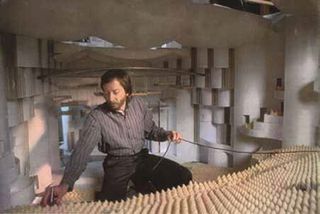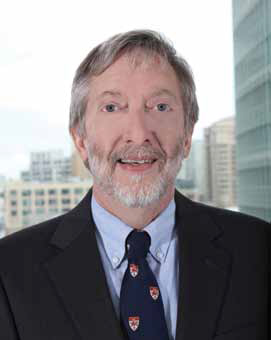Kurt Graffy, principal consultant, Arup Acoustics. “Looking back, it’s always easy to see how your choices formed the paths that led to where you are… and although it’s clear now, being an acoustician definitely wasn’t in my original plan.”
Kurt Graffy is sitting in the Arup SoundLab in Arup Acoustics’ San Francisco, CA office. He’s principal consultant at the firm, and has been working there for the last 15 years. He’s been an acoustical consultant for almost 30. But when he was younger, he thought he’d make a good aeronautical engineer/patent lawyer.
Graffy attended the University of San Francisco for engineering, but after three years realized that “I’d had it with hours of homework with slide rules and log tables, plus, there weren’t many girls in engineering!” he joked. He changed his major to technical theatre, where he could satisfy his interest in technology and people at the same time. (Which worked out pretty well; he met his wife Cathay in the theatre department.) He also noticed that in technical theater, you get paid. “Actors will line up 20 deep for an audition to get no money, and you can come in and do the lighting design or the set design––not that it’s much money––but you will actually get paid. Also, in technical theater you actually have skills that are transferable to the outside world in terms of being able to make a living.” And so, when technical theater wasn’t paying enough, Graffy could supplement his income by building decks and re-wiring houses.
Armed with a technical theatre degree he worked as the tech director and taught technical theater at Lone Mountain College (now part of the University of San Francisco) for a few years until––at the urging of Jack Davis, his friend and mentor––he left academia to be head of sound for the San Francisco Arts Commission’s Neighborhood Arts Program. (But he never lost his love of teaching, and he has taught numerous SynAudCon classes and Audio Engineering Society (AES) tutorials and workshops over the years… not to mention eight years of writing a column for SCN.) After four years with the Arts Commission he left to form his own company, Spectra Design, doing lighting and sound design.
This led to a number of technical positions in the arts world, including Special Exhibitions Lighting Designer for the San Francisco Asian Art Museum, resident sound designer for the One-Act Theater Company, and lighting and sound for both music tours and local theatres such as the Magic Theater and the Eureka Theater. “Working for myself, I was the best boss I ever had––I just didn’t pay myself regularly enough,” he said.

Graffy was offered his first job as an audio designer when he went to a SynAudCon class on concert hall design in 1985. When his wife decided to go back to school to complete her master’s degree, he went to work as a field engineer for the now defunct Data General, a computer manufacturer, and learned digital circuits. “That was quite a change, going from the arts community to the business community. And one of the first things you realize is that, actually, your time is valuable,” he said. “In the arts world the show opens at eight o’clock and you do whatever is necessary to make that happen––you get paid X amount of dollars, but you won’t get paid X-plus amount of dollars. So your sense of the worth of your time is very different than a job where after five-thirty you get time-and-a-half, and after midnight you get double time.”
Still, Graffy continued doing technical theater and lighting for the Asian Art Museum (when he wasn’t earning time-and- a-half), but it would be four years before he returned to the audio world officially, thanks to Dan Dugan, another friend and mentor. Graffy went to a SynAudCon class on concert hall design hoping to network into an audio job. Nobody was hiring, but when Graffy relayed this to Dugan, the latter mentioned that a San Francisco firm, Paoletti-Lewitz Associates (later to become Paoletti Associates) was in need of an audio designer. Did he know anyone who would be interested? “Yes!” Graffy exclaimed, “Me!” That was 1985, and Graffy would remain at Paoletti Associates until 1998, when he left to co-found Arup’s San Francisco acoustics and AV practice.
What continues to excite Graffy about acoustics is that it’s not simply quantifiable by measurement, although measurement has seen huge improvements in 30 years. “There’s a huge untapped field, which is psychoacoustics––understanding why people perceive something as pleasurable or not,” he said.
Graffy is also inspired by how advancements in technology can be leveraged to allow collaborative decision-making between consultants and their clients. Referring to the Arup SoundLab, he noted that no longer must he or his colleagues write reports for clients (which are never read) to convey the acoustic choices for their facilities––they can let them hear for themselves instead. “Reading about sound is like dancing about food,” he said. “It’s such an incongruous way of conveying information.” At Arup, consultants can utilize the SoundLab, an ambisonic environment that can recreate three-dimensional sound fields, allowing clients to come in and simply listen and decide.
Learning how things work and why they work that way is what led Graffy into this industry––and after all these decades, he’s pleased to say there’s still a great deal to learn. He urged those entering the industry to not only learn the fundamentals of acoustics, audio, or audiovisual, but to understand what technology is there for. “Technology is really only there as a means, hopefully, of improving some kind of communication,” he said. “A lot of times, you go into a project and people are so technology-centric. But what does the client do? What’s their culture of communication? Who’s the audience and who’s the presenter? What’s the style of presentation? You need to try to learn: What is this whole environment of communication about?”
Carolyn Heinze is a freelance writer/editor.










